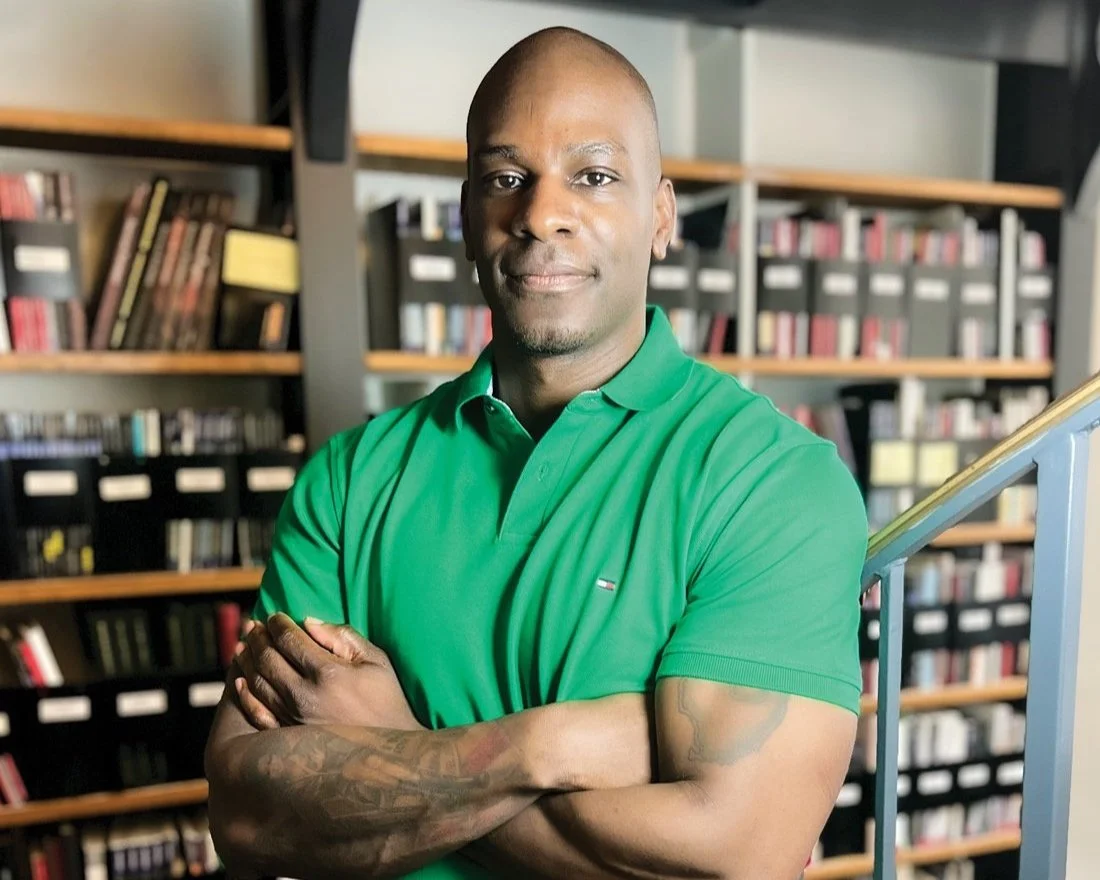Diversity, Equity, Inclusion & Belonging Begin with Listening
Get to Know Mackenzie Carr, NYSID’s First Director of DEIB
In his role as NYSID’s first Director of DEIB, Mackenzie Carr interfaces with every department at the College, from Student Services to Academic Affairs, Admissions, and IT. He brings with him a passion born of his experiences, and the adaptability that comes from having lived and worked abroad in several countries. He’s building on the foundation provided by NYSID’s DEI Commission—formerly headed by trustee Cheryl Durst, faculty member Leyden Lewis, and registrar Jennifer Melendez—and working with NYSID’s leaders to create and implement a comprehensive DEIB plan.
What Drives Him
Carr was raised in Florida. As early as age 3 or 4, he was aware of his family members being called racist slurs. He grew up with the knowledge that his father was so alienated by systemic oppression that he dropped out of Columbia University in his final year, months before obtaining his JD, to become a Black Panther.
When Carr was only eleven, his father died of colon cancer. His mother had to explain to him that they would not return to bury his father in his hometown of Pahokee, Florida, because the farm owners burn sugarcane in this rural BIPOC community for six months of the year, and toxic carcinogens fall on people in the form of “Black Snow,” causing asthma and other health problems. His mother didn’t want to expose him and his siblings to this toxic environment, even for the duration of a funeral. This was a defining moment for him. “It hurt to understand, as a child, how poorly Black people were being treated. This knowledge, in the context of my father’s death, is what activated me and set me on a course to try to change the world. By the time I was 14, I was running car washes trying to raise money for environmental and social justice causes.”
Carr thought he would major in environmental studies in college at the University of Florida, but he would end up majoring in psychology, working to help everyone from women with eating disorders to people with addictions. The early trauma of his father’s passing left him with empathy, and a desire to help people and communities. He obtained his MS in psychology, while interning with social scientists abroad. He then had an opportunity to go to South Korea and serve as the Diversity, Equity, and Inclusion Campus Coordinator and Assistant Professor of Cultural Competency at Hannam University for eight years. In 2021, he returned to the U.S. to become Assistant Director of Equity, Inclusion and Anti-bullying at Columbia University Climate School.
His international perspective and understanding of what it means to live as an expat is valuable to the NYSID community, where 21% of the students hailed from other countries in the 2023-24 academic year.
Defining DEIB at NYSID
Carr’s definition of DEIB (Diversity, Equity, Inclusion and Belonging) is one that takes every community member’s needs into account and allows for a growth mindset. DEI is a multifaceted practice that must encompass race, ethnicity, religion, gender, sexuality, socioeconomic background, neurodiversity, disability, and much more, while “belonging” is about building a community that hears and welcomes everyone. “There is never a one-size-fits-all solution,” he says. “I really want to broaden the scope of what people understand DEI to be and disrupt the status quo of DEI being specifically and only tethered to BIPOC folks, women, the LGBTQIA+ community, and differently abled people. Anyone with the will can learn. To bring about real change, you must provide empathy and allow people to make mistakes, encourage curiosity about other cultures, and not judge people for what they don’t know. That’s what I hope to emphasize.”
Building Culture Takes Patience
Carr feels that a common misconception about the practice of DEIB is that a person from an underrepresented group will come on campus and just tell people what to do. That’s not how it works. “It’s important to me that people understand that I won’t be dictating policy. An autocratic approach never works in the practice of DEIB. You cannot come onto any campus and give people procedures and policies without knowing the campus culture and where the gaps are.” Carr made small observations from the moment he stepped on campus in July 2023, but he refrained from making formal recommendations at the outset, because he believes one must gather impressions and empirical data from the students, staff, faculty, board members, and alumni before creating a hierarchy of priorities.
“Listening is key. We have to listen to understand the differences between people. I’m working to get to know just about everyone involved with the school,” he says. “The next step is surveying the community, so we have numerical data in addition to testimonials. Step three is working with departments to draft practices that lead to campus-wide policies for identifying KPIs (key performance indicators) so we can measure progress. The goal is having every department on campus running in unison with the College’s global DEIB practices.”
He views the leaders of each department as his partners and expects some of the best ideas to be theirs. He says, “I want folks to feel we are working together to ensure that our efforts are effective, transparent, and succinct in achieving our cultural goals for NYSID.” He sees students as the most important source of information about what needs to change and has an open-door policy for them. “The students know the changes that are coming before I can, and exactly what they want or need to be successful,” he adds.
Emerging Priorities
The College has not completed its DEIB plan, but Carr points to directions that are emerging as priorities. They are:
Building the Pipeline to Interior Design
NYSID is already working to educate high schoolers from underserved communities about the practice of interior design through its Pre-College Program and Pre-College Scholarship Fund. Carr would like the College to do more experiential workshops in K-12 schools, specifically the art departments of large public schools. He believes there are many artistic students who don’t know what interior design is or that it can be a career for them, especially in BIPOC communities.
Cultural Competency Training for Faculty & Staff
“The inclusion piece should come before diversity. You don’t have to be from an underrepresented group to be culturally competent. Prepare your campus for the students you want to attract,” says Carr. He adds, “I have been able to work alongside the HR office to develop trainings.” Carr is building a series of trainings and workshops specific to the needs of NYSID and interior designers.
Attracting Traditional-Aged Students Means Welcoming Their Parents
Carr notes that there is a hesitation among some parents about sending their 18- or 19-year-old undergrads to a single-discipline school, and a worry about the economic prospects and stability of interior design as a career. He feels that NYSID could try additional methods to attract and keep more students by welcoming family members and guardians to the campus. He hopes to set up a parent orientation that sheds light on the economics of interior design and demonstrates the proven path to employment NYSID provides.
Emboldening Everyone to Speak Up
Carr says, “I’ve noticed that many people at NYSID have great and innovative ideas. However, many of those people don’t feel confident enough to share these ideas or know to whom they should direct them. Therefore, the priority is to keep ongoing communications going while welcoming and including new voices.”
Getting things done requires engaging as many community members as possible in the transformation. What’s important to Carr is meaningful change. He notes, “Culture is what we do, not just what we say.” Reach out to Carr with your ideas: mackenzie.carr@nysid.edu.

